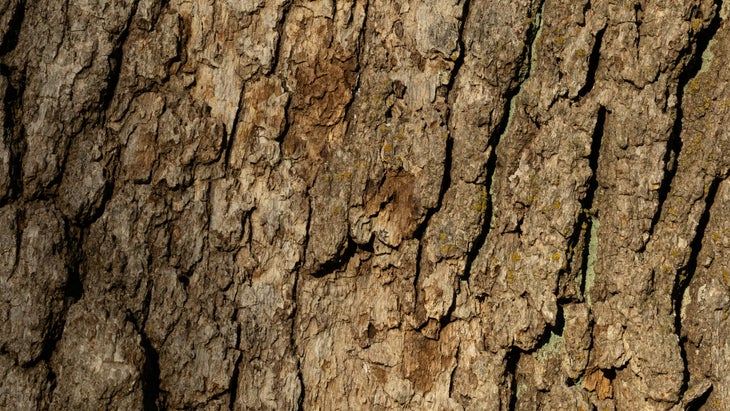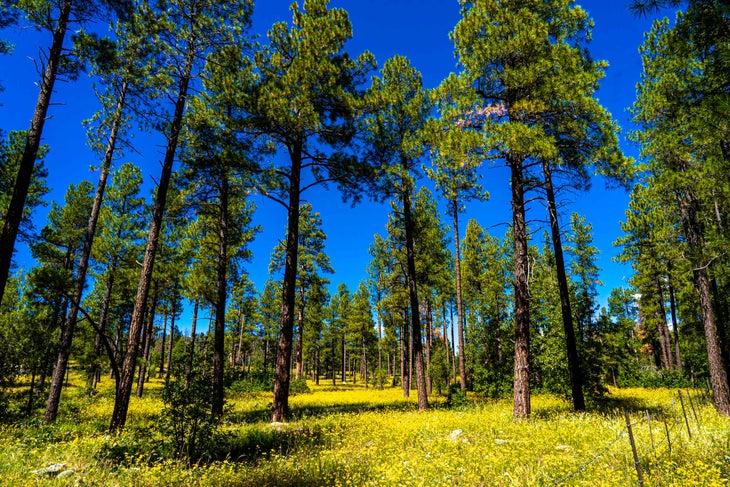“], “filter”: { “nextExceptions”: “img, blockquote, div”, “nextContainsExceptions”: “img, blockquote, a.btn, a.o-button”} }”>
Heading out the door? Read this article on the new Outside+ app available now on iOS devices for members!
>”,”name”:”in-content-cta”,”type”:”link”}}”>Download the app.
If you’ve ever wanted to be the kind of hiker who can tell the difference between a Doug fir and a pine tree, you’ve come to the right place. Every species of tree has unique characteristics, from its bark to its leaves, that you can use as clues to identify it—without using the internet.
Beyond using this knowledge as a party trick to impress others, naturalist Carey Russell, believes that learning the names of the trees that we hike past reinforces our bond and participation with nature, and gives us a deeper appreciation of the places we go for enjoyment.
For backpackers, tree identification is useful for teaching us more about a particular bioregion or ecosystem while we’re spending time there. It teaches us the vocabulary of the landscape.
“Just as we could learn to speak French or Mandarin, we should be learning how to speak nature,” says New York-based naturalist Carey Russell. “Trees are a good place to start.”
To put together this beginner’s guide for tree identification, we talked with Russell, of The Dendro Lab, a masterclass, podcast, and workshop series for tree identification.
How to Start Identifying Trees
The best way to start identifying trees is in your own backyard. You likely already know the names of some common trees, such as a dogwood or a maple, that you can look for on your neighborhood walks or regular hikes. “Think of it as a scavenger hunt,” Russell says.
By working outward from the center of your current knowledge, you will begin to better understand tree families, then genuses, then species. Under the genus umbrella are your commonly known trees, such as ash, birch, walnut, dogwood, myrtle, rose, and maple.
Each tree has broad patterns—like leaf shape or bark texture—across multiple species that will help you classify them. Then to narrow it down to its species, you’ll look for one or two little less noticeable attributes to tell it apart. For instance, the length of its stem or fine hairs on the leaf. Here are some other clues to help you identify the tree in front of you on the trail:
Clue 1: Environment
Certain trees grow in certain regions, so knowing where you are can help narrow down the species. Are you in a temperate forest? A tropical zone where you’re surrounded by palm trees? Or are you in the Pacific Northwest where Doug firs and Western hemlocks are abundant?

Clue 2: Leaves
Many naturalists and arborists look first to a tree’s leaves. Some trees are coniferous, meaning they have pointed needles, like spruce and redwood trees. These types of trees also typically drop cones. Other trees are broadleaf, meaning they have flat leaves instead of needles, like maple and oak trees. They’re the kinds of leaves you crunch when they drop and dry up in fall.
Get closer to a branch to notice more attributes. Oppositely arranged leaves have two leaves attached at a single point, while alternately arranged leaves have one leaf attached at each point on the stem, like oak, beech, and walnut trees. Russell says about 20 percent of trees have oppositely arranged leaves, such as ash, dogwood, and maple trees.
Now look at the shape of the leaves. Palmately lobed means the lobes radiate from a single point, like the maple leaf on the Canadian flag. Pinnately lobed, however, means the lobes and are arranged on either side of a single axis or vein, like that of an oak leaf.
Russell next looks at the leaf margin, or edge, noticing whether it’s smooth or toothy. Then he’ll turn the leaf over to examine the stem, color, and texture.

Clue 3: Bark
Examining the bark, such as when you wrap your arms around it and give it a big hug, is another way to identify a tree. Bark has a few different classifications:
- Scaly bark is overlapping and squarish, like lizard skin. Oak and dogwood trees have scaly bark.
- Papery bark is usually white and looks like it can be peeled. Birch trees and aspen trees are good examples.
- Smooth bark is just as it’s named—you can run your hands over it. Sycamores and maple trees are common examples.
- Furrowed bark has deep grooves and chunky vertical strips. Redwoods and Doug firs have this kind of bark.

Clue 4: Flowers, Fruit, Acorns, and Cones
Depending on the season, a tree may flower or fruit, or bear acorns or cones. Junipers produce small blue berries, while cypress trees grow round cones. Be sure to look on the ground around the tree for any droppings that will help you with recognition.

Clue 5: Overall Structure
Finally, noticing the height, width, and growth pattern of a tree can help you hone in on its true name. Is it tall? Is it wide? Does the bottom look shaggy? Does it lean in the wind? Just like with all the other attributes, every tree has a unique shape and size.
Resources for Tree Identification
There are a number of tree and plant identification apps out there, but Russell believes that using field guides and other print research is better for retaining information. The Sibley Guide to Trees is one example, and the National Audubon Society offers many field guides.
Finding a mentor and joining a group of dendro-curious people is another way to hone your recognition skills. Many communities and conservation centers host tree walks and talks; there are just as many tree ID groups as there are birding groups.
